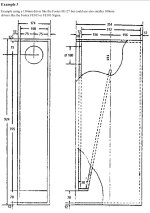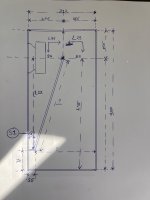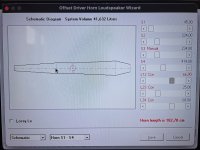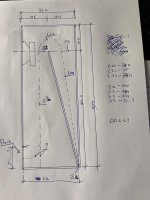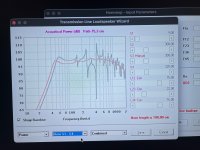Hello! 😃
I have a question about (folded) Voigt pipe speakers. (TQWT)
I’m thinking of making such a folded Voigt pipe speaker and I have seen some YT video’s of how a voigt pipe speaker(cabinet) works, but not in great detail.
It doesn't look/seems to look very difficult yet.
The difficulties for now are ‘putting everything into Hornresp.
I have two questions about that.
1: I have a drawing of the cabinet I want to base my speaker cabinet on, and there is a drawing (not to scale) I made with some S-L values in Hornresp.
But it’s a bit unclear to me what surface area and what length exactly what I have to fill in to Hornresp? I see some differences in what I have found on the internet.
2: I want to places full range driver and I want to know/see the full frequency response of the speaker when it’s finished.
Can I simulate that in Hornresp? If yes: How?
Hope someone here can help me a little further with this project.
Thanks in advance! 🙏🏻
I have a question about (folded) Voigt pipe speakers. (TQWT)
I’m thinking of making such a folded Voigt pipe speaker and I have seen some YT video’s of how a voigt pipe speaker(cabinet) works, but not in great detail.
It doesn't look/seems to look very difficult yet.
The difficulties for now are ‘putting everything into Hornresp.
I have two questions about that.
1: I have a drawing of the cabinet I want to base my speaker cabinet on, and there is a drawing (not to scale) I made with some S-L values in Hornresp.
But it’s a bit unclear to me what surface area and what length exactly what I have to fill in to Hornresp? I see some differences in what I have found on the internet.
2: I want to places full range driver and I want to know/see the full frequency response of the speaker when it’s finished.
Can I simulate that in Hornresp? If yes: How?
Hope someone here can help me a little further with this project.
Thanks in advance! 🙏🏻
Attachments
Last edited:
Yes you can andshouldmodel with HornResp.
The Zd, pipe length, cross-section ,terminus area and depth (ie mass loading) all have an affect. You start with theTS parameters of the driver you want to use.
dave
The Zd, pipe length, cross-section ,terminus area and depth (ie mass loading) all have an affect. You start with theTS parameters of the driver you want to use.
dave
No, you cannot include the driver's specific frequency response into a hornresp simulation.2: I want to places full range driver and I want to know/see the full frequency response of the speaker when it’s finished.
Can I simulate that in Hornresp? If yes: How?
But you can simulate the low frequency range of your speaker very well, based on TS-parameters and the simplified enclosure model.
Baffle diffraction impact, driver beaming and breakup, eventual other driver-inherent resonance effects cannot be simulated/included.
Do you think the L-S values are right in my drawing? I have doubts.Yes you can andshouldmodel with HornResp.
The Zd, pipe length, cross-section ,terminus area and depth (ie mass loading) all have an affect. You start with theTS parameters of the driver you want to use.
dave
How can I get a prediction of the full frequency response?No, you cannot include the driver's specific frequency response into a hornresp simulation.
But you can simulate the low frequency range of your speaker very well, based on TS-parameters and the simplified enclosure model.
Put your model values into HR and then look at the schematic view and compare that to the pictures of the design.Do you think the L-S values are right in my drawing? I have doubts.
Do you think the L-S values are right in my drawing? I have doubts.
One would need to simulate theline to know.
dave
Thank you! I’m gonna look when I understand what I’m seeing in Hornresp😉@Niek you can use VItuixcad for that, but of course the result depends on the data you feed it with. You could even export the low frequency response from hornresp and merge it in vituixcad to your measured or datasheet-response.
I absolutely do not understand the schematic view in HR 🫣Put your model values into HR and then look at the schematic view and compare that to the pictures of the design.
I don’t see how I see the whole speaker and all of it’s dimensions 🤷🏻♂️
So I have some studying to do.
I still don’t know in how many segments the TQWT has? I still don’t know exactly where the L-S values stands for 🤷🏻♂️If that doesn't clear things up, let us know what you have and where you're stuck.
Same with the values: Con, L12, L23, L45
I don’t think it’s difficult to play with the sliders, but I still can’t find how to fill in the values for a tqwt.
Look in the help file under Horn Parameters. You can search for that exact phrase under the File menu in the help, BTW.
When asking for HR related design how-to, etc., please Export, Attach the file for us to Download, install to maximize a timely response. TIA
Apparently you have not yet seen the PM from Sunday? We will help, but very seldom will we do it for you w/o seeing you try first (it's DIYaudio).Does anyone have an idea how this TQWT type to setup in HR?
How about the ‘port’ in the bottom left?
I have a S1 at the bottom and it’s also a port. Is this possible?
Thank you 🙏🏻
Hello again!
A question about how accurate HornResp is.
Here i have an example I made in HR. I think the response will be quite accurate below 150Hz. But how accurate is it between 200-1000Hz. What are the experiences here in that regard?
The question is about the red line.
Cabinet: TQWT. 4 sections.
Driver location: Between section 2-3
Damping is also placed virtually.
A question about how accurate HornResp is.
Here i have an example I made in HR. I think the response will be quite accurate below 150Hz. But how accurate is it between 200-1000Hz. What are the experiences here in that regard?
The question is about the red line.
Cabinet: TQWT. 4 sections.
Driver location: Between section 2-3
Damping is also placed virtually.
Attachments
- Home
- Loudspeakers
- Full Range
- TWQT / Hornresp help needed
